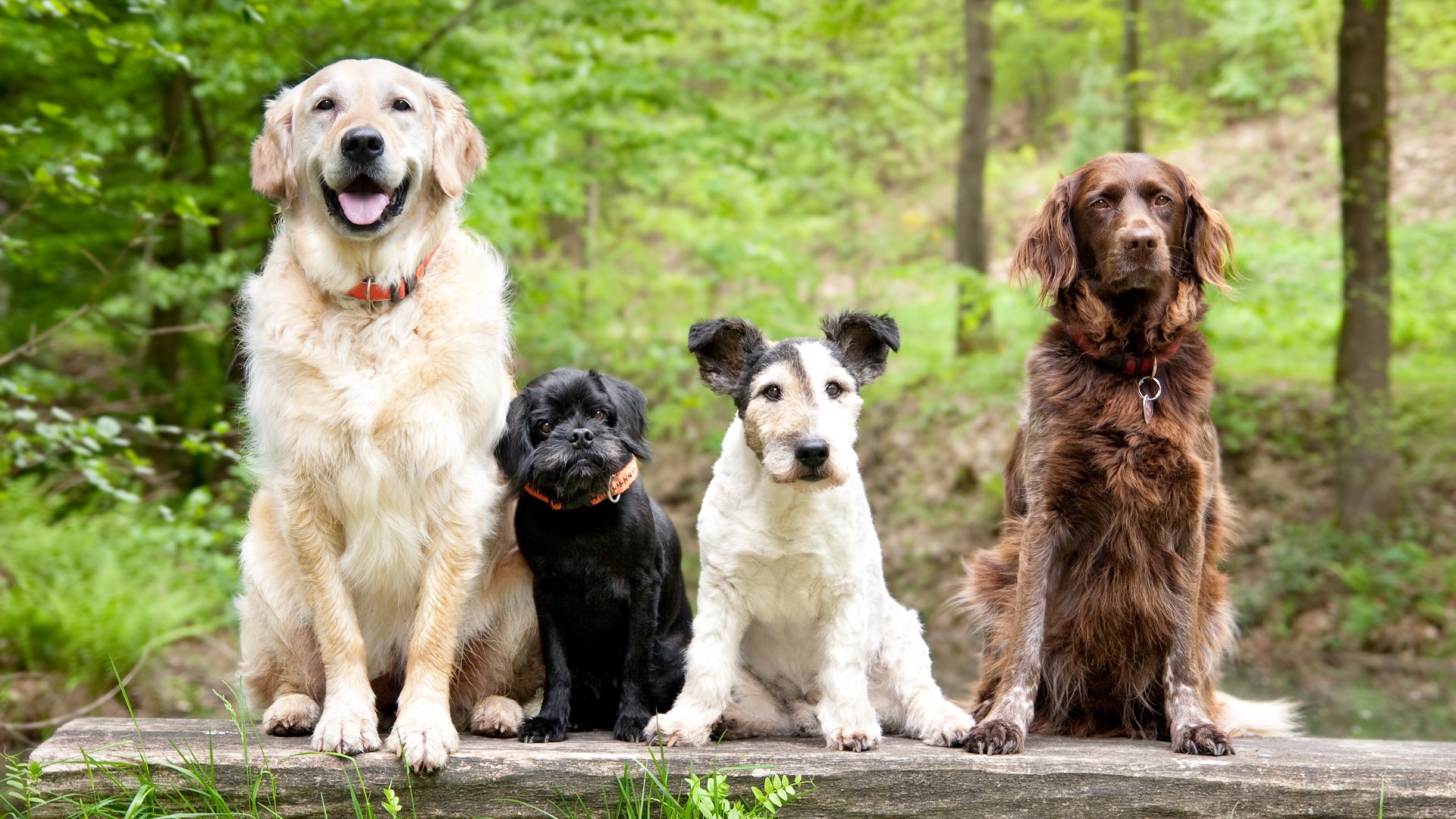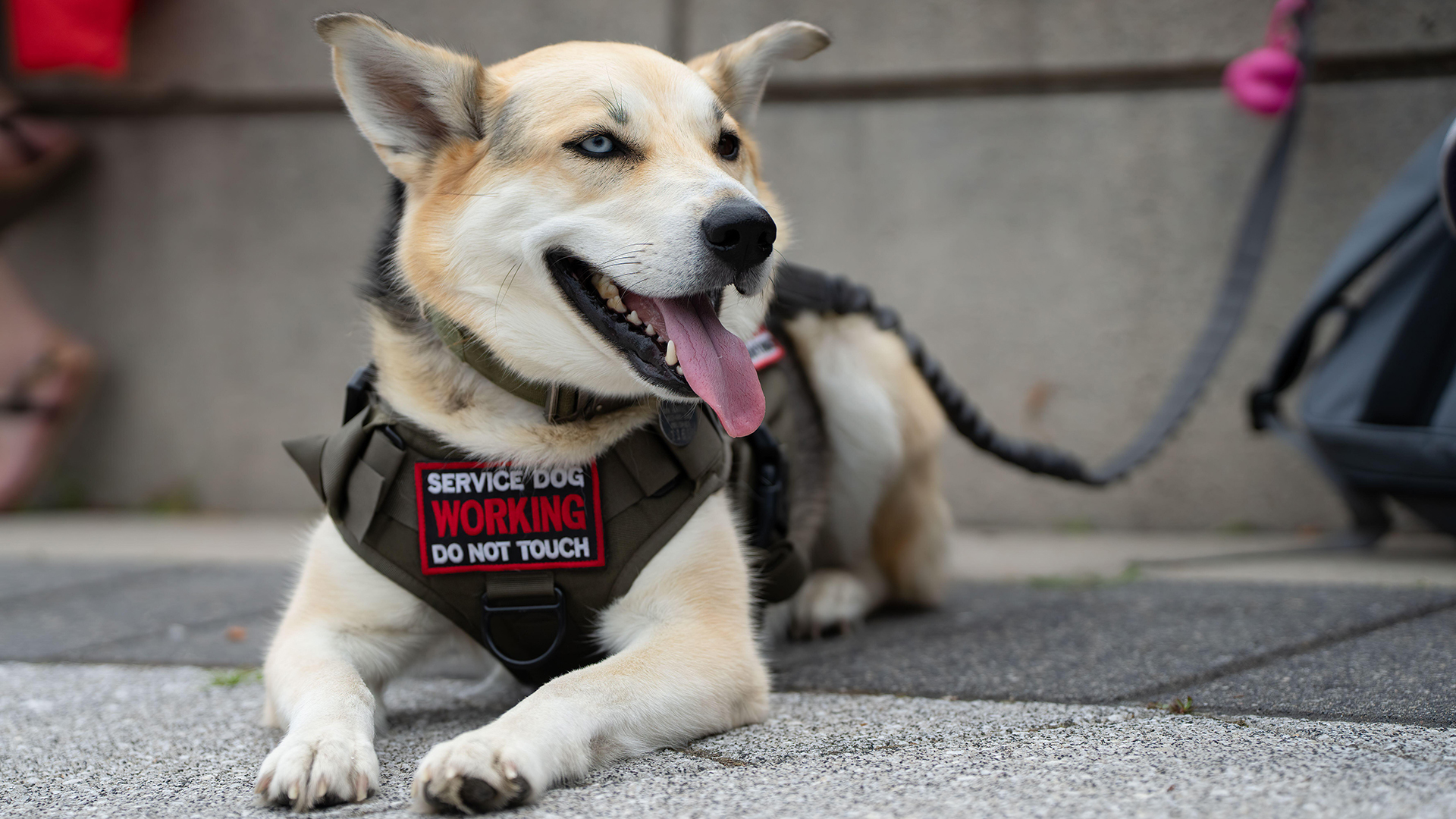Dogs: History, evolution and behavior of our best friends
Dogs and humans have been companions for thousands of years.

It hardly seems like a dainty teacup poodle and a wrinkly Neapolitan mastiff could belong to the same species, much less the same subspecies. But both are Canis lupus familiaris, the beloved domestic dog.
A member of the family Canidae — along with wolves, foxes, coyotes and jackals — dogs have been human companions for at least 14,000 years (and possibly much longer than that). Much about how dogs and humans became inseparable remains a mystery, but research finds that the bond is very real. As many pet owners may already attest, there is evidence that dogs understand human distress and want to help their owners when they're sad.
Despite the diversity of domestic dogs, these animals share an evolutionary history and behavioral traits.
When were dogs domesticated?
The closest living relative to modern dogs is the gray wolf (Canis lupus). The ancestor of modern dogs and the ancestor of modern wolves probably split at some point in the late Pleistocene, the last ice age. Genetic studies put different dates on this split. One 2014 study based on the mutation rates found that the schism happened between 9,000 and 34,000 years ago, and that the wolf population dogs split from later went extinct. Another genetic study from 2017 put the window between 20,000 and 40,000 years ago.
The oldest fossil that scientists agree came from a dog, rather than a wolf, comes from a site in Germany called Bonn-Oberkassel and dates back about 14,200 years. But archaeologists have found fossil specimens that might be domesticated dogs dating back more than 30,000 years. It's difficult to confidently identify a Pleistocene fossil fragment as being from either a dog or a wolf, and because dogs and wolves interbred even after they diverged genetically, genomic studies are complicated. Researchers also debate whether dog domestication happened once or at multiple sites around the world.
"We don't know where in the world it happened," Anders Bergström, a postdoctoral fellow in ancient genomics at the Francis Crick Institute in London, told Live Science in 2022. "We don't know what human group was involved, and we don't know whether it happened once or multiple times."
It is clear that humankind's bond with dogs goes way back. The 14,200-year-old dog from Bonn-Oberkassel was buried with two humans and had been nursed through several episodes of canine distemper before it died. In a 12,000-year-old cemetery in Israel, a woman was found buried with her hand on a small wolf or dog puppy. A Stone Age dog from what is now Sweden was buried with a human companion about 8,400 years ago, researchers reported in 2020.
What are dog breeds?
In the time since domestication, humans have shaped dogs like clay: Sometimes it seems like the only things different dog breeds have in common are four legs and a tail. The American Kennel Club (AKC) currently recognizes 200 breeds, and that list doesn't even begin to touch the diversity of hybrid breeds (Labradoodles, anyone?) and uncategorizable mutts (often the best kind).
The AKC isn't the final arbiter of what makes a dog breed. According to the organization, there are some 400 dog breeds registered around the world. AKC registration just means there are enough of a certain breed in the United States and enough interest from owners in documenting a breeding history and a "breed standard," which is a description of the ideal characteristics of a breed.

Picking dogs with certain traits and breeding to maximize those traits has led to dogs specialized for many different tasks. Labrador retrievers, for example — which often top the lists of most popular breeds in the United States — have webbed toes and a two-layered coat that is resistant to water. These are traits left over from the breed's original role of retrieving downed ducks for duck hunters. According to the AKC, Labradors were bred from the St. John's dog, a water-loving breed used in early Newfoundland fisheries to retrieve nets and lines.
The sausage-like dachshund, on the other hand, is a poor swimmer but a keen hunter. It was bred for its narrow body and digging acumen, all the better for burrowing into badger dens and killing the occupants, according to the AKC.
Though most official modern breeds date back to the Victorian era, a 2010 paper did find divergence between some breeds indicating that they emerged 500 or more years ago. These breeds were the basenji, Afghan hound, Samoyed, saluki, Canaan dog, New Guinea singing dog, dingo (a wild canine), chow chow, Chinese shar-pei, Akita, Alaskan malamute, Siberian husky and American Eskimo dog.
Do dogs see color? (And other dog senses)

Dogs can see yellow and green hues, but they can't distinguish red from green — a similar situation to humans who are red-green color-blind. However, dogs may be more sensitive to ultraviolet light than humans are, according to 2014 research, in which case they would be better at sensing a wider ranges of blues than people are.
Dog vision is almost three times blurrier than human vision, according to a 2017 study. In that research, whippets, pugs and Shetland sheepdogs were trained with treats to distinguish lines that were different distances from one another. These lines were then used to give the dogs a visual test, not unlike the alphabet chart a human might see during a visit to the eye doctor. Dogs had about 20/50 vision, the study found, meaning that something a human could see clearly at a distance of 50 feet (15 meters), a dog could see clearly at 20 feet (6 m). Dogs, however, do see better than people in dim light, according to the Merck Manual for Veterinary Medicine, and can see movement better, too. One special feature that magnifies light to a dog's eye is the tapetum lucidum, a reflective layer that also gives dogs their characteristic eyeshine at night.
Hearing and smell are where dogs really shine. According to the Merck Manual, dogs hear about four times better than humans do. Incredibly, their sense of smell is a whopping thousand to ten thousand times better than ours. The olfactory center of a dog's brain is 40 times the size of the olfactory center in a human's brain. Because dogs can distinguish between smells with great sensitivity, they have been trained to sniff out human diseases: researchers discovered in the early 2000s that dogs can sniff out signs of early stage cancers, and in 2021 scientists found that dogs could identify COVID-19 in the scent of urine samples, Live Science previously reported.
Can dogs feel emotions?
Humans and dogs really do understand each other. A 2014 study found that emotional processing regions of dogs' brains respond to human emotional sounds, like laughing and crying, in the same way as these regions respond to dog emotional sounds, like whining or yipping. Humans, too, process dog emotional sounds in the same way they process human emotional sounds.
But what emotions do dogs feel? And what do they understand about others' emotions?
It's pretty clear that dogs experience basic emotions, like pleasure, sadness, anxiety and fear, said Julia Meyers-Manor, a psychologist at Ripon College in Wisconsin who studies animal emotions. Meyers-Manor led a 2018 study that found that dogs showed stress in response to their owners' crying noises and that dogs were more likely to attempt to comfort or help a crying owner compared with a laughing owner. Follow-up research that has not yet been published suggests that dogs attempt to comfort upset strangers, too, though not as readily as they comfort their owners, Meyers-Manor told Live Science.

"There's quite a bit of consistency in brain areas that process emotions across mammal species," she said. Dogs are social animals, so it's not surprising that they'd respond to the emotions of others. It is interesting, however, that dogs respond to emotions across species, she said. It's possible that crying is similar enough among species to elicit a response no matter what animal is crying and what animal is listening, she said. It's also possible that, because dogs have co-evolved with humans for so long, they're particularly good at interpreting human emotion. More research comparing different species' reactions is needed to clear up these questions, Meyers-Manor said.
Despite these similarities, one thing is certain: Your dog probably doesn't feel guilt when it digs up the flower beds and knocks over the trash. Though many dog owners take the pitiful, droopy-eyed look a dog gives when it senses trouble to mean that their dogs know exactly what they did wrong, a 2009 study found that the guilty look is simply a way to stay out of trouble. In that study, dogs were put into situations where they were framed for doing something wrong, like eating a forbidden treat. Even when the dogs had not eaten the treat, they looked guilty when their owners thought they had and scolded them.
In other words, the expression that humans interpret as guilt is nothing of the sort. It's just a reaction to a scolding human. "They've just learned, make this expression when there's a big mess in the house and owners won't kill you," Meyers-Manor said.
How smart are dogs?

Dogs are pretty smart, though not "exceptional," according to a 2018 study in the journal Learning & Behavior. The study compared dogs with other carnivores, with other social hunters, and with other domesticated animals, looking at definitions of intelligence that covered sensory cognition, physical cognition, spatial cognition, social cognition and self-awareness. These comparisons focused on other species for which intelligence studies had been conducted, which mainly included wolves, hyenas, African wild dogs, cats, bottlenose dolphins, chimpanzees, horses and pigeons.
On the whole, the researchers concluded, dogs have sensory abilities similar to those of other hunting carnivores. They're pretty bad at solving problems involving objects, such as pulling a string to get at a treat attached to the other end. Spatial cognition, which involves understanding places and navigation, was harder to compare, the researchers found, but there did not seem to be any evidence that dogs were standouts compared with other hunters. Dogs were impressive at using other animals' behavior to cue their own and did beat out many other similar animals at social learning, though dolphins and chimps might be better at imitation. Finally, unlike dolphins and chimpanzees, dogs don't show many signs of self-awareness, or the ability to project themselves mentally into the past or future by remembering events like a story or planning for future events.
Dog smarts are about what would be expected from a domesticated social carnivore and hunter, the researchers concluded in their paper. Dogs are socially savvy, paying attention to cues from other dogs and from humans, their evolutionary co-pilots. They have sensory abilities and spatial smarts sufficient to navigate the environment of a pack hunter. But they aren't as good at things that don't matter as much to their survival, such as figuring out how objects work or making detailed plans for the future.
How do dogs help people?
Humans and dogs have been working together for a long time. Though the earliest history of dogs is shrouded in mystery, there are hints that humans may have used dogs to help with hunts as long as 14,000 years ago, according to a 2019 study in the Journal of Anthropological Archaeology. In Saudi Arabia, rock art estimated to be about 8,000 years old shows humans hunting with dogs on leashes, killing ibex and gazelles, ScienceAlert reported.

Today, dogs still help hunters stalk quarry large and small. Labrador retrievers continue to be used to hunt ducks, while sprinters such as the Pharaoh hound are excellent at catching prey such as rabbits.
Dogs are also used by police and the military, often to sniff out drugs or explosives, to perform search and rescue operations, and to bite and hold suspects. According to the AKC, police dogs are usually breeds that have been bred to be highly trainable, including German shepherds, Labrador retrievers, and bloodhounds.
Modern dogs also play a huge role as service dogs, therapy dogs and emotional support animals. Guide Dogs or Seeing Eye Dogs help people with vision loss navigate obstacles. Therapy dogs are used to support and calm people with autism, post-traumatic stress disorder, anxiety and other conditions. There are even squads of good-natured dogs roaming airports (with their handlers, of course), calming nervous travelers with snuggles.
Additional resources
Check out the Humane Society of America for more on pet dog behavior and welfare. The American Kennel Club is an exhaustive reference on dog breeds, health, and training. For a deep and detailed dive into what scientists know (and don't) about how dogs were domesticated and came to the Americas, read the 2021 paper "Dog domestication and the dual dispersal of people and dogs into the Americas," which is freely available.
Originally published on Live Science.
Sign up for the Live Science daily newsletter now
Get the world’s most fascinating discoveries delivered straight to your inbox.

Stephanie Pappas is a contributing writer for Live Science, covering topics ranging from geoscience to archaeology to the human brain and behavior. She was previously a senior writer for Live Science but is now a freelancer based in Denver, Colorado, and regularly contributes to Scientific American and The Monitor, the monthly magazine of the American Psychological Association. Stephanie received a bachelor's degree in psychology from the University of South Carolina and a graduate certificate in science communication from the University of California, Santa Cruz.










